University of Wolverhampton: Social Media & Brand Loyalty Case Study
VerifiedAdded on 2023/04/23
|95
|19860
|277
Case Study
AI Summary
This case study investigates the effect of social media on brand loyalty within the e-commerce business, specifically focusing on Souq, a major e-commerce platform in the UAE. The research explores the challenges Souq faces in achieving brand loyalty despite its use of social media for marketing. The study examines the impact of social media marketing on customer purchase habits and brand loyalty, analyzing factors such as content relevance, customer engagement, and competitive market dynamics. The research methodology includes a survey of 50 participants and utilizes correlation and regression analysis to assess the relationship between social media marketing and brand loyalty. Key findings reveal a positive correlation between social media and brand loyalty for Souq, highlighting social media's effectiveness in customer engagement and its role in influencing purchase decisions. The study concludes with recommendations for Souq to enhance its social media strategies and improve customer loyalty in the competitive e-commerce market.
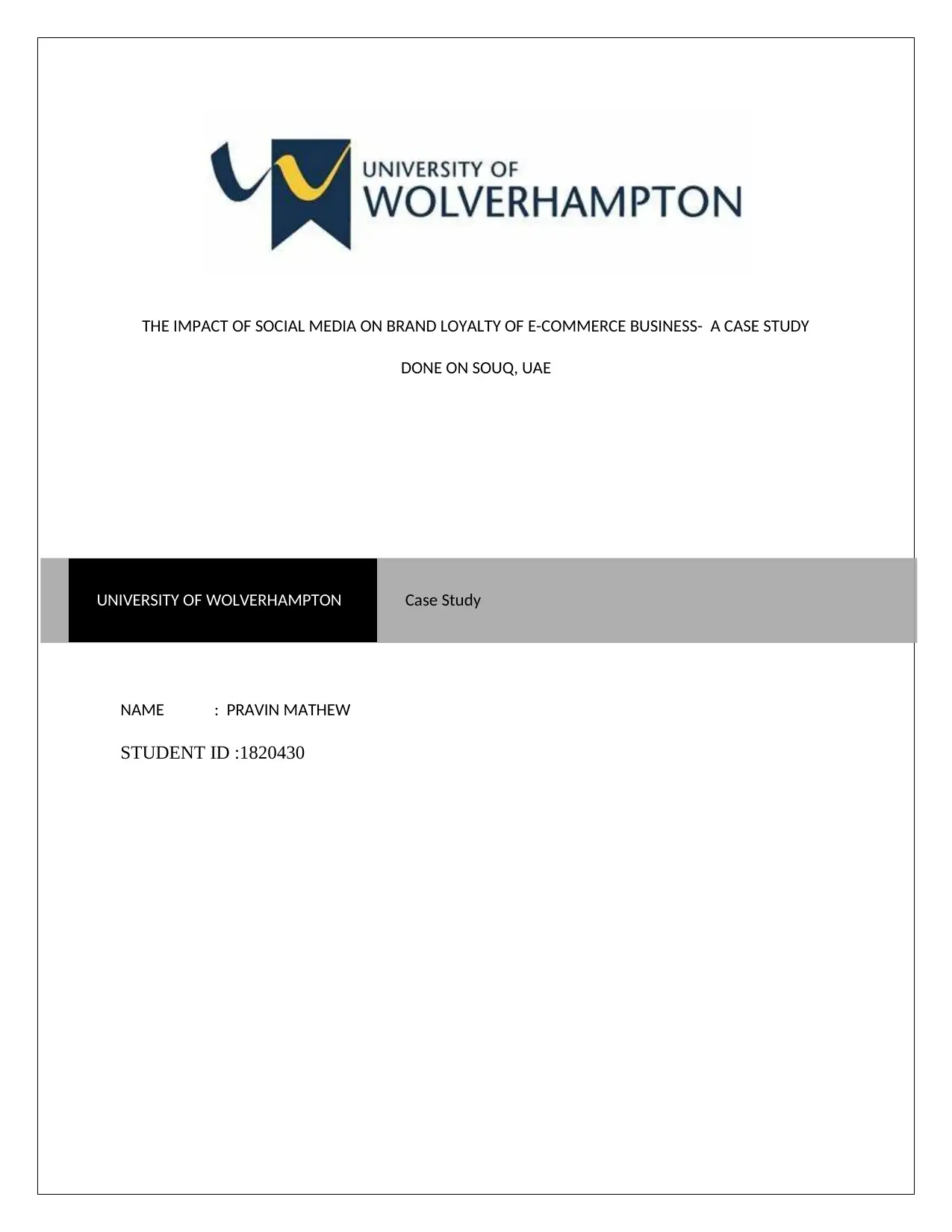
THE IMPACT OF SOCIAL MEDIA ON BRAND LOYALTY OF E-COMMERCE BUSINESS- A CASE STUDY
DONE ON SOUQ, UAE
NAME : PRAVIN MATHEW
STUDENT ID :1820430
UNIVERSITY OF WOLVERHAMPTON Case Study
DONE ON SOUQ, UAE
NAME : PRAVIN MATHEW
STUDENT ID :1820430
UNIVERSITY OF WOLVERHAMPTON Case Study
Paraphrase This Document
Need a fresh take? Get an instant paraphrase of this document with our AI Paraphraser
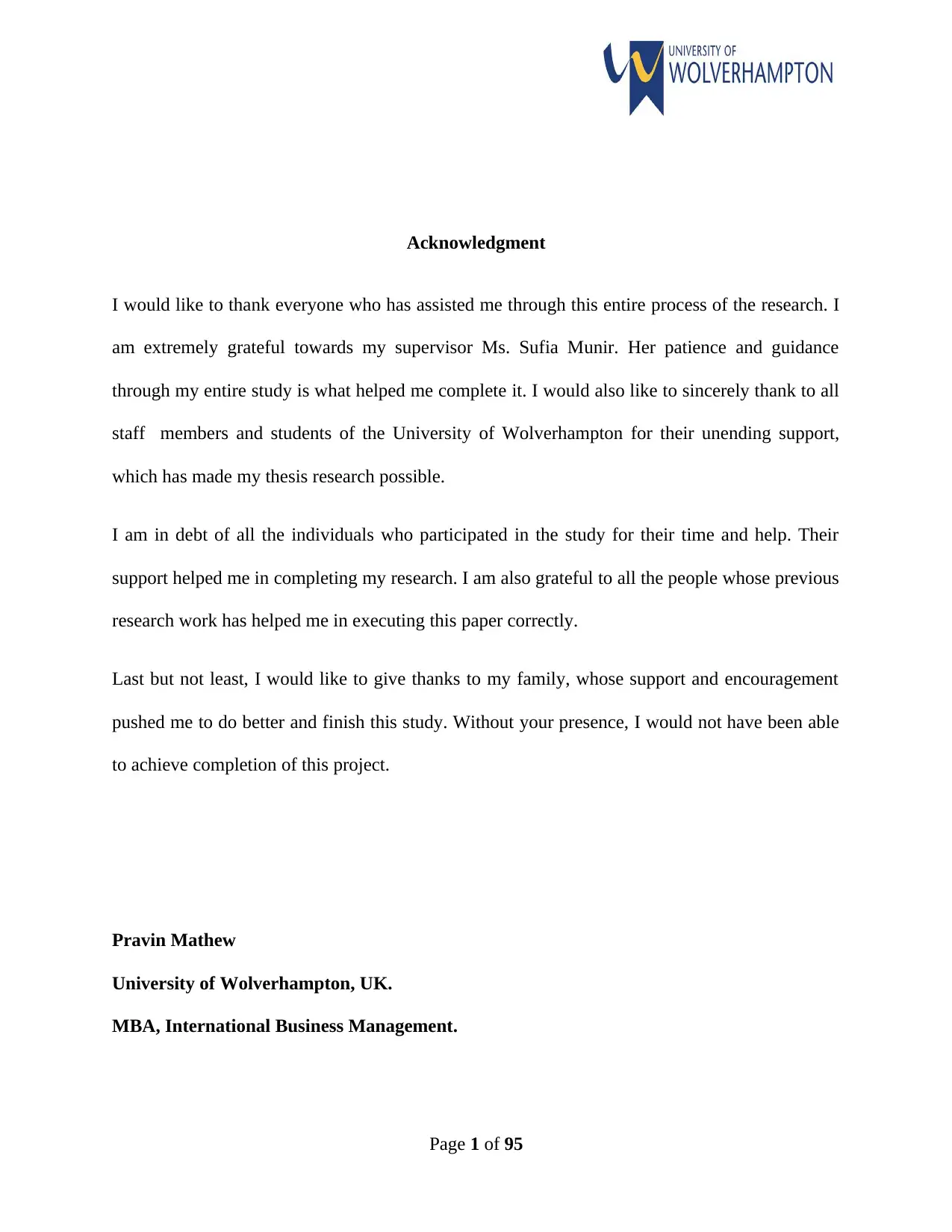
Acknowledgment
I would like to thank everyone who has assisted me through this entire process of the research. I
am extremely grateful towards my supervisor Ms. Sufia Munir. Her patience and guidance
through my entire study is what helped me complete it. I would also like to sincerely thank to all
staff members and students of the University of Wolverhampton for their unending support,
which has made my thesis research possible.
I am in debt of all the individuals who participated in the study for their time and help. Their
support helped me in completing my research. I am also grateful to all the people whose previous
research work has helped me in executing this paper correctly.
Last but not least, I would like to give thanks to my family, whose support and encouragement
pushed me to do better and finish this study. Without your presence, I would not have been able
to achieve completion of this project.
Pravin Mathew
University of Wolverhampton, UK.
MBA, International Business Management.
Page 1 of 95
I would like to thank everyone who has assisted me through this entire process of the research. I
am extremely grateful towards my supervisor Ms. Sufia Munir. Her patience and guidance
through my entire study is what helped me complete it. I would also like to sincerely thank to all
staff members and students of the University of Wolverhampton for their unending support,
which has made my thesis research possible.
I am in debt of all the individuals who participated in the study for their time and help. Their
support helped me in completing my research. I am also grateful to all the people whose previous
research work has helped me in executing this paper correctly.
Last but not least, I would like to give thanks to my family, whose support and encouragement
pushed me to do better and finish this study. Without your presence, I would not have been able
to achieve completion of this project.
Pravin Mathew
University of Wolverhampton, UK.
MBA, International Business Management.
Page 1 of 95

Abstract
Presentation Title : The Impact of Social Media on Brand Loyalty of E-commerce Business
Research focus : A case study on Souq,UAE
Student Level : Masters
Year : 2019
Language : English Language
Name of Supervisor : SufiaMunir
This research aims to inspect the effect and influence of social media on the operations of the e-
commerce business called Souq. It has been difficult for the business to achieve brand loyalty
through the use of social media. This has happened because of an increase in market competition
and a change in the trends of competition. Using social media for promotion purposes can be an
effective tool to reach out to cutomers. But Souq has been unable to produce content for their
social media that would attract customers. This is because the company is lacking a clear vision
for their brand which could attract new customers or convince the existing ones to stay. Souq is
registered as a United Arab Emirates based English-Arabic e-commerce site, which is the largest
e-commerce platform that operates in UAE and is owned by Amazon. The net estimated value of
the e-commerce site is $580 million for which Amazon undertook it. The platform was founded
in 2005 and was undertaken on 28th March 2017. The significance of the research lies in the fact
that it will help researchers help in understanding the correlation between social media and
creating brand loyalty, in this case, for Souq. The rationale behind the research is to investigate
and analyze the influence that social media creates on customers’ purchase habits and how it
could affect Souq’s endeavour at creating brand loyalty on the e-commerce site in United Arab
Page 2 of 95
Presentation Title : The Impact of Social Media on Brand Loyalty of E-commerce Business
Research focus : A case study on Souq,UAE
Student Level : Masters
Year : 2019
Language : English Language
Name of Supervisor : SufiaMunir
This research aims to inspect the effect and influence of social media on the operations of the e-
commerce business called Souq. It has been difficult for the business to achieve brand loyalty
through the use of social media. This has happened because of an increase in market competition
and a change in the trends of competition. Using social media for promotion purposes can be an
effective tool to reach out to cutomers. But Souq has been unable to produce content for their
social media that would attract customers. This is because the company is lacking a clear vision
for their brand which could attract new customers or convince the existing ones to stay. Souq is
registered as a United Arab Emirates based English-Arabic e-commerce site, which is the largest
e-commerce platform that operates in UAE and is owned by Amazon. The net estimated value of
the e-commerce site is $580 million for which Amazon undertook it. The platform was founded
in 2005 and was undertaken on 28th March 2017. The significance of the research lies in the fact
that it will help researchers help in understanding the correlation between social media and
creating brand loyalty, in this case, for Souq. The rationale behind the research is to investigate
and analyze the influence that social media creates on customers’ purchase habits and how it
could affect Souq’s endeavour at creating brand loyalty on the e-commerce site in United Arab
Page 2 of 95
⊘ This is a preview!⊘
Do you want full access?
Subscribe today to unlock all pages.

Trusted by 1+ million students worldwide
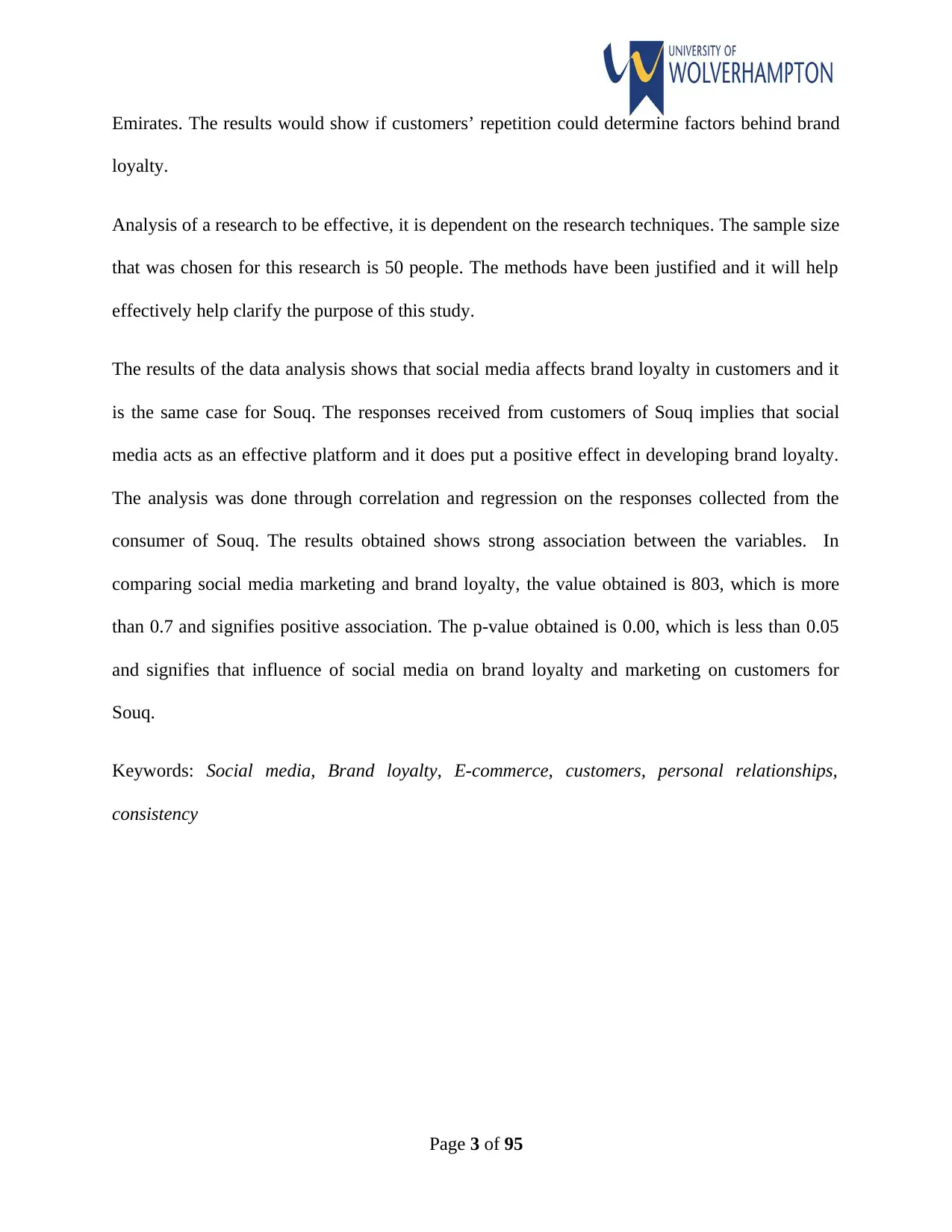
Emirates. The results would show if customers’ repetition could determine factors behind brand
loyalty.
Analysis of a research to be effective, it is dependent on the research techniques. The sample size
that was chosen for this research is 50 people. The methods have been justified and it will help
effectively help clarify the purpose of this study.
The results of the data analysis shows that social media affects brand loyalty in customers and it
is the same case for Souq. The responses received from customers of Souq implies that social
media acts as an effective platform and it does put a positive effect in developing brand loyalty.
The analysis was done through correlation and regression on the responses collected from the
consumer of Souq. The results obtained shows strong association between the variables. In
comparing social media marketing and brand loyalty, the value obtained is 803, which is more
than 0.7 and signifies positive association. The p-value obtained is 0.00, which is less than 0.05
and signifies that influence of social media on brand loyalty and marketing on customers for
Souq.
Keywords: Social media, Brand loyalty, E-commerce, customers, personal relationships,
consistency
Page 3 of 95
loyalty.
Analysis of a research to be effective, it is dependent on the research techniques. The sample size
that was chosen for this research is 50 people. The methods have been justified and it will help
effectively help clarify the purpose of this study.
The results of the data analysis shows that social media affects brand loyalty in customers and it
is the same case for Souq. The responses received from customers of Souq implies that social
media acts as an effective platform and it does put a positive effect in developing brand loyalty.
The analysis was done through correlation and regression on the responses collected from the
consumer of Souq. The results obtained shows strong association between the variables. In
comparing social media marketing and brand loyalty, the value obtained is 803, which is more
than 0.7 and signifies positive association. The p-value obtained is 0.00, which is less than 0.05
and signifies that influence of social media on brand loyalty and marketing on customers for
Souq.
Keywords: Social media, Brand loyalty, E-commerce, customers, personal relationships,
consistency
Page 3 of 95
Paraphrase This Document
Need a fresh take? Get an instant paraphrase of this document with our AI Paraphraser
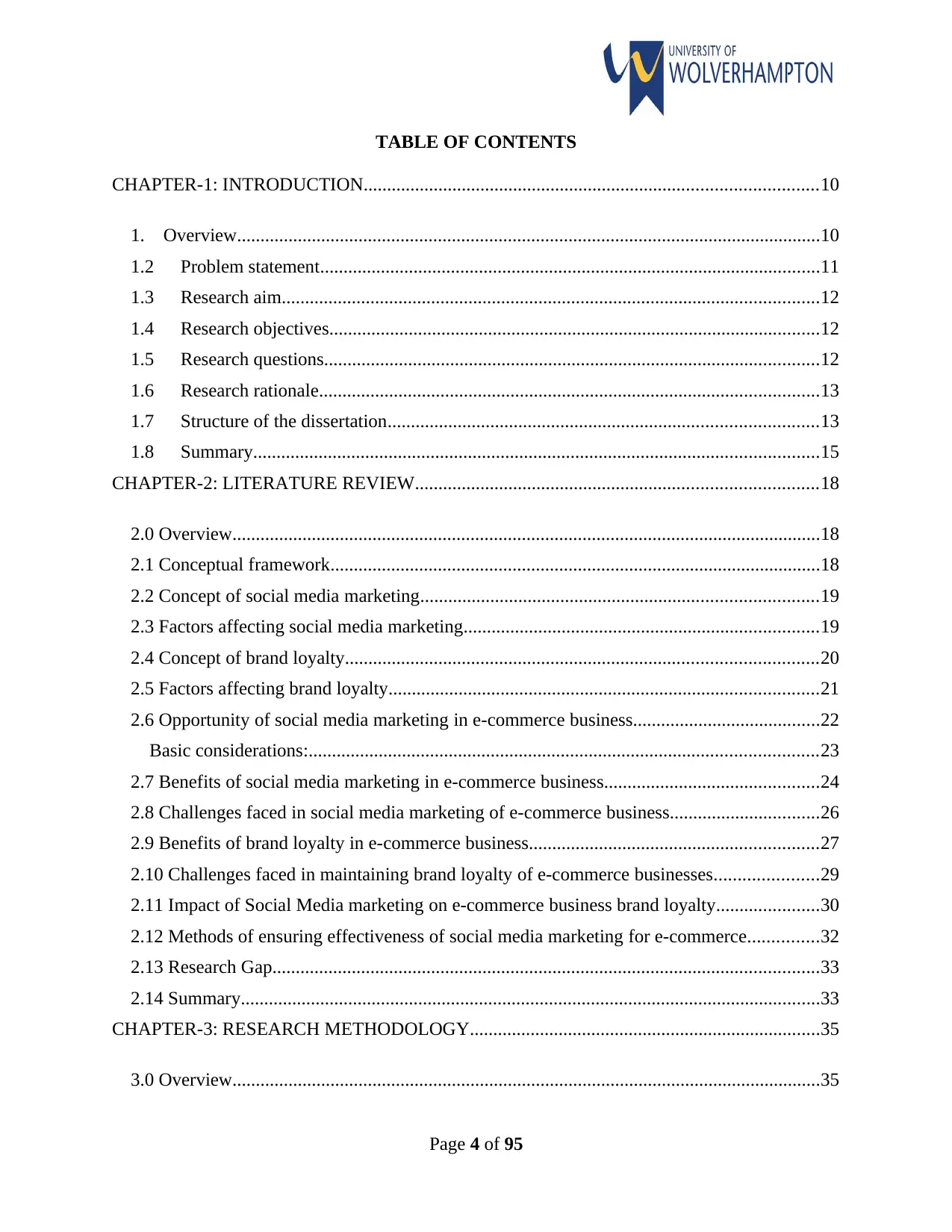
TABLE OF CONTENTS
CHAPTER-1: INTRODUCTION.................................................................................................10
1. Overview.............................................................................................................................10
1.2 Problem statement...........................................................................................................11
1.3 Research aim...................................................................................................................12
1.4 Research objectives.........................................................................................................12
1.5 Research questions..........................................................................................................12
1.6 Research rationale...........................................................................................................13
1.7 Structure of the dissertation............................................................................................13
1.8 Summary.........................................................................................................................15
CHAPTER-2: LITERATURE REVIEW......................................................................................18
2.0 Overview..............................................................................................................................18
2.1 Conceptual framework.........................................................................................................18
2.2 Concept of social media marketing.....................................................................................19
2.3 Factors affecting social media marketing............................................................................19
2.4 Concept of brand loyalty.....................................................................................................20
2.5 Factors affecting brand loyalty............................................................................................21
2.6 Opportunity of social media marketing in e-commerce business........................................22
Basic considerations:.............................................................................................................23
2.7 Benefits of social media marketing in e-commerce business..............................................24
2.8 Challenges faced in social media marketing of e-commerce business................................26
2.9 Benefits of brand loyalty in e-commerce business..............................................................27
2.10 Challenges faced in maintaining brand loyalty of e-commerce businesses......................29
2.11 Impact of Social Media marketing on e-commerce business brand loyalty......................30
2.12 Methods of ensuring effectiveness of social media marketing for e-commerce...............32
2.13 Research Gap.....................................................................................................................33
2.14 Summary............................................................................................................................33
CHAPTER-3: RESEARCH METHODOLOGY...........................................................................35
3.0 Overview..............................................................................................................................35
Page 4 of 95
CHAPTER-1: INTRODUCTION.................................................................................................10
1. Overview.............................................................................................................................10
1.2 Problem statement...........................................................................................................11
1.3 Research aim...................................................................................................................12
1.4 Research objectives.........................................................................................................12
1.5 Research questions..........................................................................................................12
1.6 Research rationale...........................................................................................................13
1.7 Structure of the dissertation............................................................................................13
1.8 Summary.........................................................................................................................15
CHAPTER-2: LITERATURE REVIEW......................................................................................18
2.0 Overview..............................................................................................................................18
2.1 Conceptual framework.........................................................................................................18
2.2 Concept of social media marketing.....................................................................................19
2.3 Factors affecting social media marketing............................................................................19
2.4 Concept of brand loyalty.....................................................................................................20
2.5 Factors affecting brand loyalty............................................................................................21
2.6 Opportunity of social media marketing in e-commerce business........................................22
Basic considerations:.............................................................................................................23
2.7 Benefits of social media marketing in e-commerce business..............................................24
2.8 Challenges faced in social media marketing of e-commerce business................................26
2.9 Benefits of brand loyalty in e-commerce business..............................................................27
2.10 Challenges faced in maintaining brand loyalty of e-commerce businesses......................29
2.11 Impact of Social Media marketing on e-commerce business brand loyalty......................30
2.12 Methods of ensuring effectiveness of social media marketing for e-commerce...............32
2.13 Research Gap.....................................................................................................................33
2.14 Summary............................................................................................................................33
CHAPTER-3: RESEARCH METHODOLOGY...........................................................................35
3.0 Overview..............................................................................................................................35
Page 4 of 95
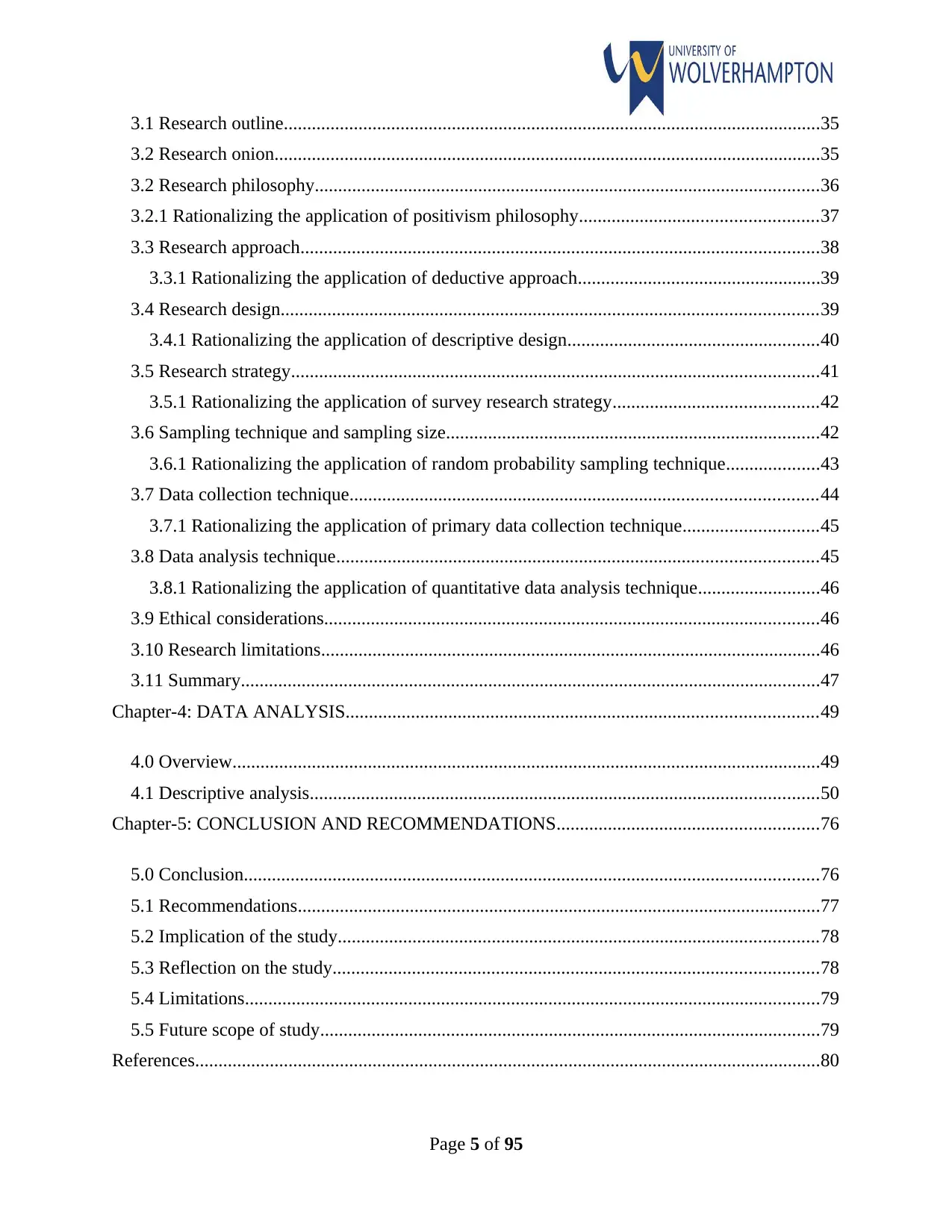
3.1 Research outline...................................................................................................................35
3.2 Research onion.....................................................................................................................35
3.2 Research philosophy............................................................................................................36
3.2.1 Rationalizing the application of positivism philosophy...................................................37
3.3 Research approach...............................................................................................................38
3.3.1 Rationalizing the application of deductive approach....................................................39
3.4 Research design...................................................................................................................39
3.4.1 Rationalizing the application of descriptive design......................................................40
3.5 Research strategy.................................................................................................................41
3.5.1 Rationalizing the application of survey research strategy............................................42
3.6 Sampling technique and sampling size................................................................................42
3.6.1 Rationalizing the application of random probability sampling technique....................43
3.7 Data collection technique....................................................................................................44
3.7.1 Rationalizing the application of primary data collection technique.............................45
3.8 Data analysis technique.......................................................................................................45
3.8.1 Rationalizing the application of quantitative data analysis technique..........................46
3.9 Ethical considerations..........................................................................................................46
3.10 Research limitations...........................................................................................................46
3.11 Summary............................................................................................................................47
Chapter-4: DATA ANALYSIS.....................................................................................................49
4.0 Overview..............................................................................................................................49
4.1 Descriptive analysis.............................................................................................................50
Chapter-5: CONCLUSION AND RECOMMENDATIONS........................................................76
5.0 Conclusion...........................................................................................................................76
5.1 Recommendations................................................................................................................77
5.2 Implication of the study.......................................................................................................78
5.3 Reflection on the study........................................................................................................78
5.4 Limitations...........................................................................................................................79
5.5 Future scope of study...........................................................................................................79
References......................................................................................................................................80
Page 5 of 95
3.2 Research onion.....................................................................................................................35
3.2 Research philosophy............................................................................................................36
3.2.1 Rationalizing the application of positivism philosophy...................................................37
3.3 Research approach...............................................................................................................38
3.3.1 Rationalizing the application of deductive approach....................................................39
3.4 Research design...................................................................................................................39
3.4.1 Rationalizing the application of descriptive design......................................................40
3.5 Research strategy.................................................................................................................41
3.5.1 Rationalizing the application of survey research strategy............................................42
3.6 Sampling technique and sampling size................................................................................42
3.6.1 Rationalizing the application of random probability sampling technique....................43
3.7 Data collection technique....................................................................................................44
3.7.1 Rationalizing the application of primary data collection technique.............................45
3.8 Data analysis technique.......................................................................................................45
3.8.1 Rationalizing the application of quantitative data analysis technique..........................46
3.9 Ethical considerations..........................................................................................................46
3.10 Research limitations...........................................................................................................46
3.11 Summary............................................................................................................................47
Chapter-4: DATA ANALYSIS.....................................................................................................49
4.0 Overview..............................................................................................................................49
4.1 Descriptive analysis.............................................................................................................50
Chapter-5: CONCLUSION AND RECOMMENDATIONS........................................................76
5.0 Conclusion...........................................................................................................................76
5.1 Recommendations................................................................................................................77
5.2 Implication of the study.......................................................................................................78
5.3 Reflection on the study........................................................................................................78
5.4 Limitations...........................................................................................................................79
5.5 Future scope of study...........................................................................................................79
References......................................................................................................................................80
Page 5 of 95
⊘ This is a preview!⊘
Do you want full access?
Subscribe today to unlock all pages.

Trusted by 1+ million students worldwide
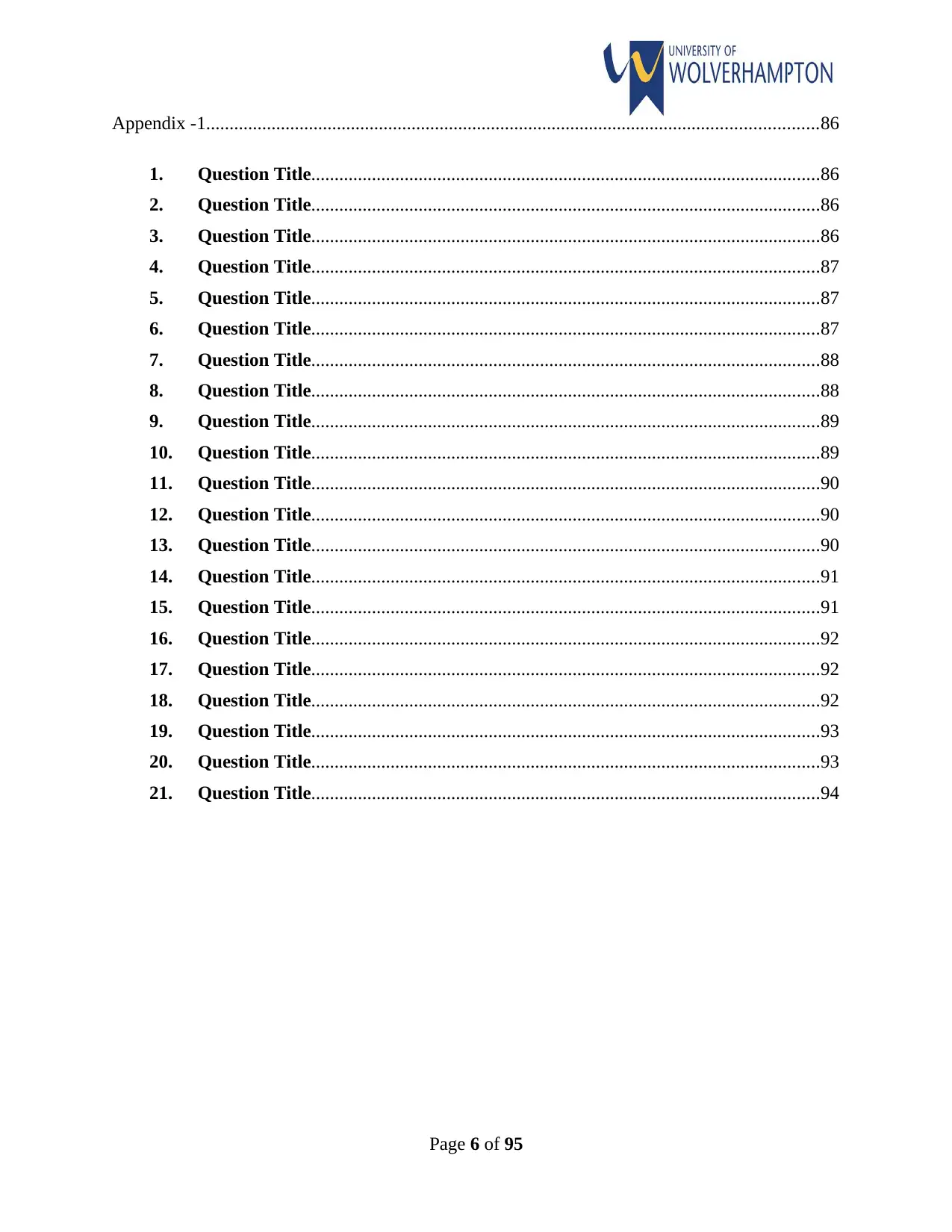
Appendix -1...................................................................................................................................86
1. Question Title.............................................................................................................86
2. Question Title.............................................................................................................86
3. Question Title.............................................................................................................86
4. Question Title.............................................................................................................87
5. Question Title.............................................................................................................87
6. Question Title.............................................................................................................87
7. Question Title.............................................................................................................88
8. Question Title.............................................................................................................88
9. Question Title.............................................................................................................89
10. Question Title.............................................................................................................89
11. Question Title.............................................................................................................90
12. Question Title.............................................................................................................90
13. Question Title.............................................................................................................90
14. Question Title.............................................................................................................91
15. Question Title.............................................................................................................91
16. Question Title.............................................................................................................92
17. Question Title.............................................................................................................92
18. Question Title.............................................................................................................92
19. Question Title.............................................................................................................93
20. Question Title.............................................................................................................93
21. Question Title.............................................................................................................94
Page 6 of 95
1. Question Title.............................................................................................................86
2. Question Title.............................................................................................................86
3. Question Title.............................................................................................................86
4. Question Title.............................................................................................................87
5. Question Title.............................................................................................................87
6. Question Title.............................................................................................................87
7. Question Title.............................................................................................................88
8. Question Title.............................................................................................................88
9. Question Title.............................................................................................................89
10. Question Title.............................................................................................................89
11. Question Title.............................................................................................................90
12. Question Title.............................................................................................................90
13. Question Title.............................................................................................................90
14. Question Title.............................................................................................................91
15. Question Title.............................................................................................................91
16. Question Title.............................................................................................................92
17. Question Title.............................................................................................................92
18. Question Title.............................................................................................................92
19. Question Title.............................................................................................................93
20. Question Title.............................................................................................................93
21. Question Title.............................................................................................................94
Page 6 of 95
Paraphrase This Document
Need a fresh take? Get an instant paraphrase of this document with our AI Paraphraser
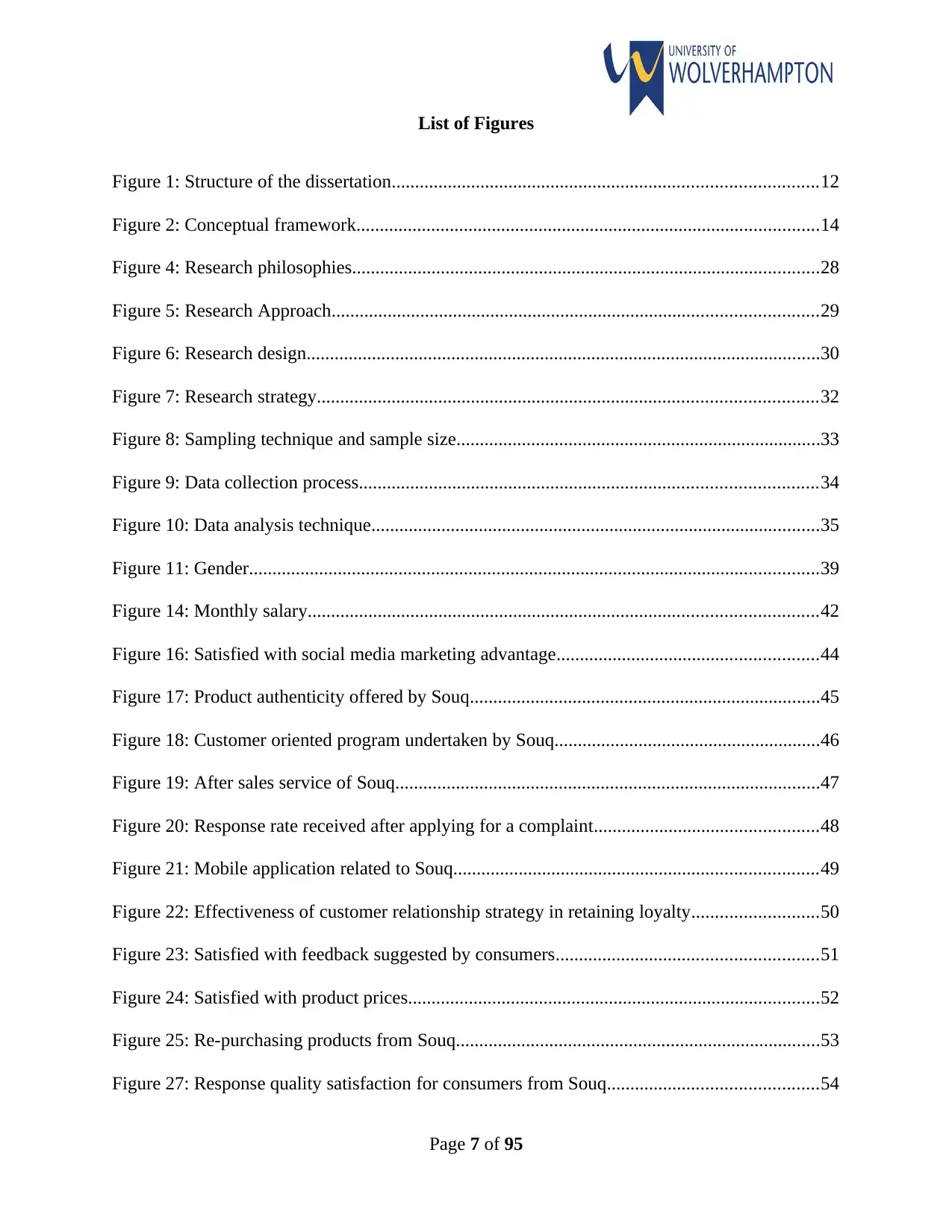
List of Figures
Figure 1: Structure of the dissertation...........................................................................................12
Figure 2: Conceptual framework...................................................................................................14
Figure 4: Research philosophies....................................................................................................28
Figure 5: Research Approach........................................................................................................29
Figure 6: Research design..............................................................................................................30
Figure 7: Research strategy...........................................................................................................32
Figure 8: Sampling technique and sample size..............................................................................33
Figure 9: Data collection process..................................................................................................34
Figure 10: Data analysis technique................................................................................................35
Figure 11: Gender..........................................................................................................................39
Figure 14: Monthly salary.............................................................................................................42
Figure 16: Satisfied with social media marketing advantage........................................................44
Figure 17: Product authenticity offered by Souq...........................................................................45
Figure 18: Customer oriented program undertaken by Souq.........................................................46
Figure 19: After sales service of Souq...........................................................................................47
Figure 20: Response rate received after applying for a complaint................................................48
Figure 21: Mobile application related to Souq..............................................................................49
Figure 22: Effectiveness of customer relationship strategy in retaining loyalty...........................50
Figure 23: Satisfied with feedback suggested by consumers........................................................51
Figure 24: Satisfied with product prices........................................................................................52
Figure 25: Re-purchasing products from Souq..............................................................................53
Figure 27: Response quality satisfaction for consumers from Souq.............................................54
Page 7 of 95
Figure 1: Structure of the dissertation...........................................................................................12
Figure 2: Conceptual framework...................................................................................................14
Figure 4: Research philosophies....................................................................................................28
Figure 5: Research Approach........................................................................................................29
Figure 6: Research design..............................................................................................................30
Figure 7: Research strategy...........................................................................................................32
Figure 8: Sampling technique and sample size..............................................................................33
Figure 9: Data collection process..................................................................................................34
Figure 10: Data analysis technique................................................................................................35
Figure 11: Gender..........................................................................................................................39
Figure 14: Monthly salary.............................................................................................................42
Figure 16: Satisfied with social media marketing advantage........................................................44
Figure 17: Product authenticity offered by Souq...........................................................................45
Figure 18: Customer oriented program undertaken by Souq.........................................................46
Figure 19: After sales service of Souq...........................................................................................47
Figure 20: Response rate received after applying for a complaint................................................48
Figure 21: Mobile application related to Souq..............................................................................49
Figure 22: Effectiveness of customer relationship strategy in retaining loyalty...........................50
Figure 23: Satisfied with feedback suggested by consumers........................................................51
Figure 24: Satisfied with product prices........................................................................................52
Figure 25: Re-purchasing products from Souq..............................................................................53
Figure 27: Response quality satisfaction for consumers from Souq.............................................54
Page 7 of 95
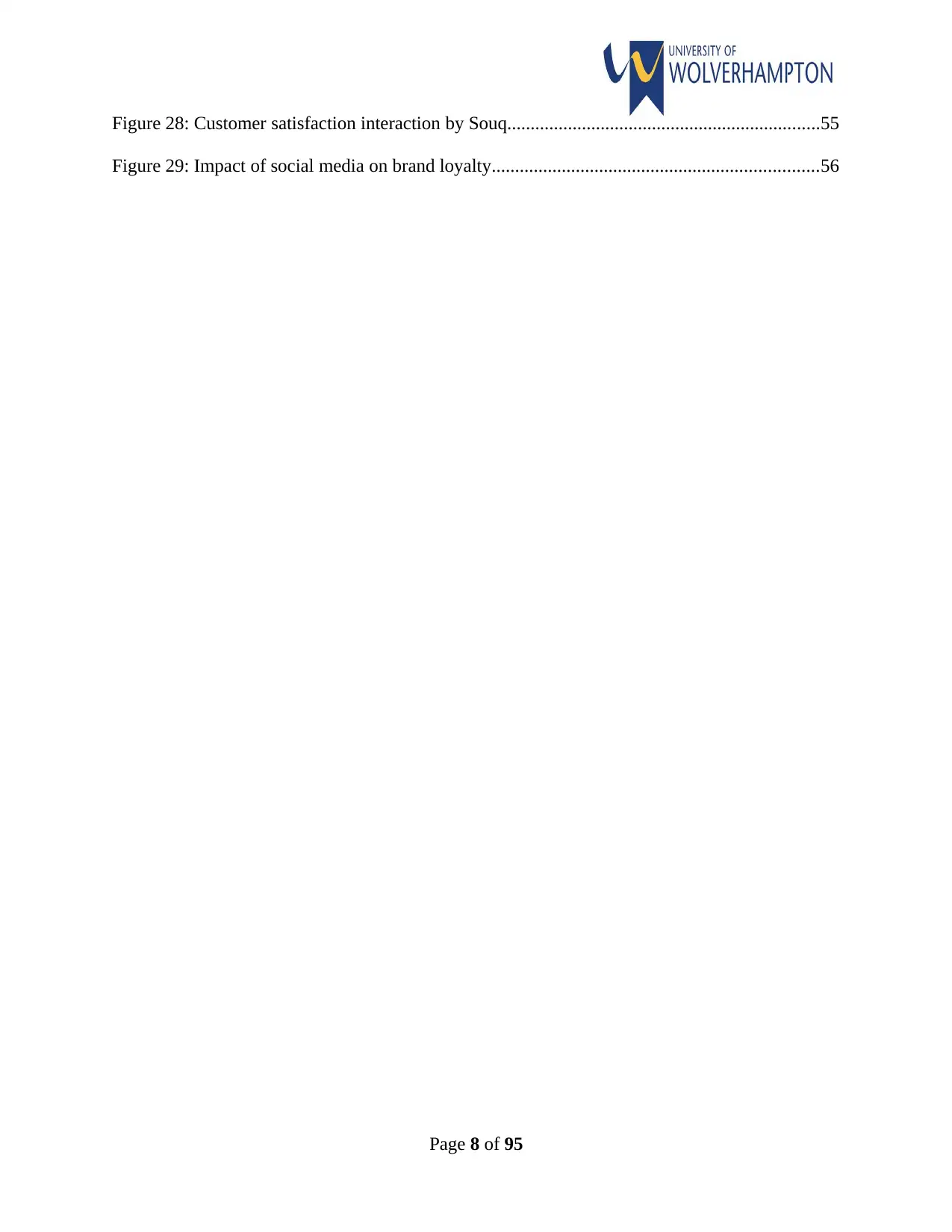
Figure 28: Customer satisfaction interaction by Souq...................................................................55
Figure 29: Impact of social media on brand loyalty......................................................................56
Page 8 of 95
Figure 29: Impact of social media on brand loyalty......................................................................56
Page 8 of 95
⊘ This is a preview!⊘
Do you want full access?
Subscribe today to unlock all pages.

Trusted by 1+ million students worldwide
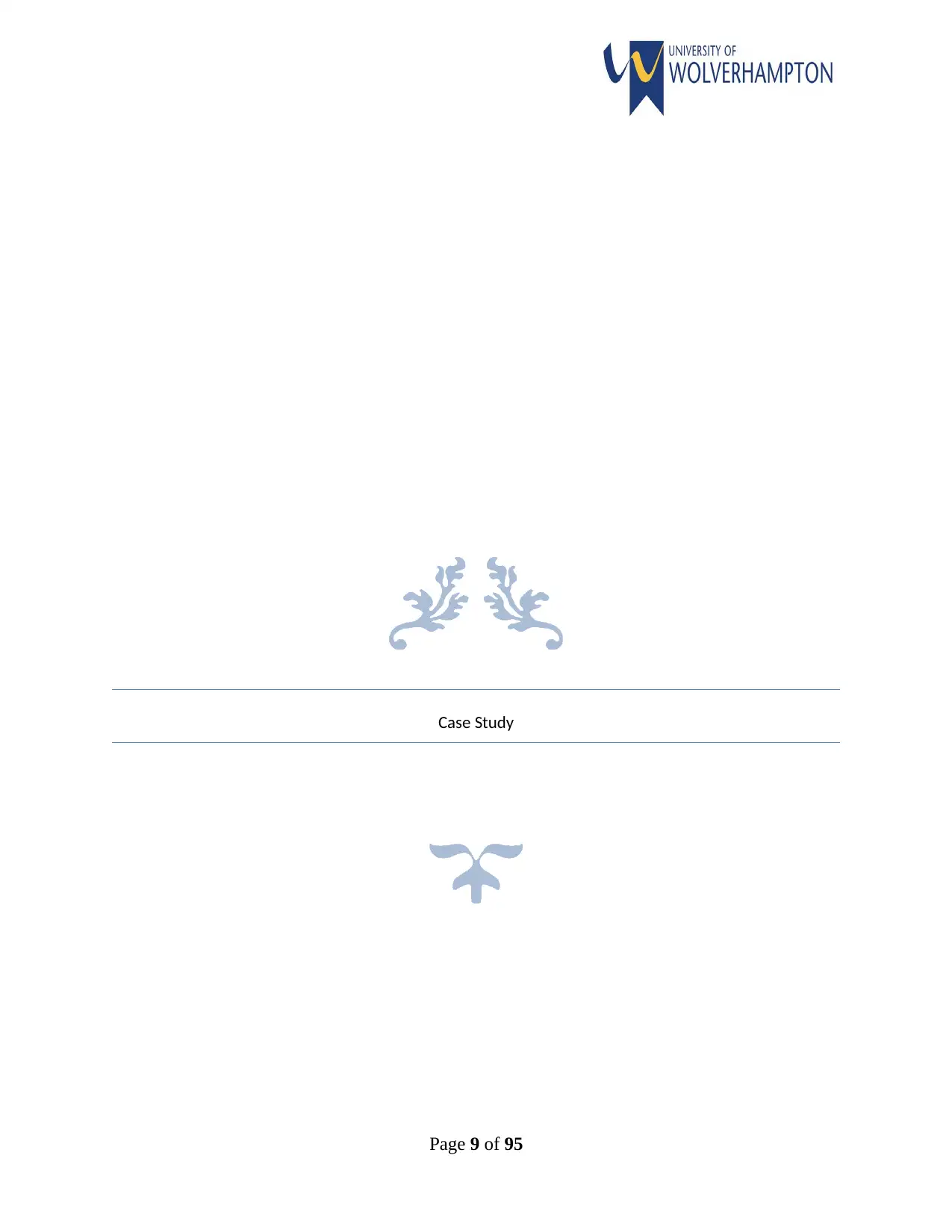
Case Study
Page 9 of 95
Page 9 of 95
Paraphrase This Document
Need a fresh take? Get an instant paraphrase of this document with our AI Paraphraser
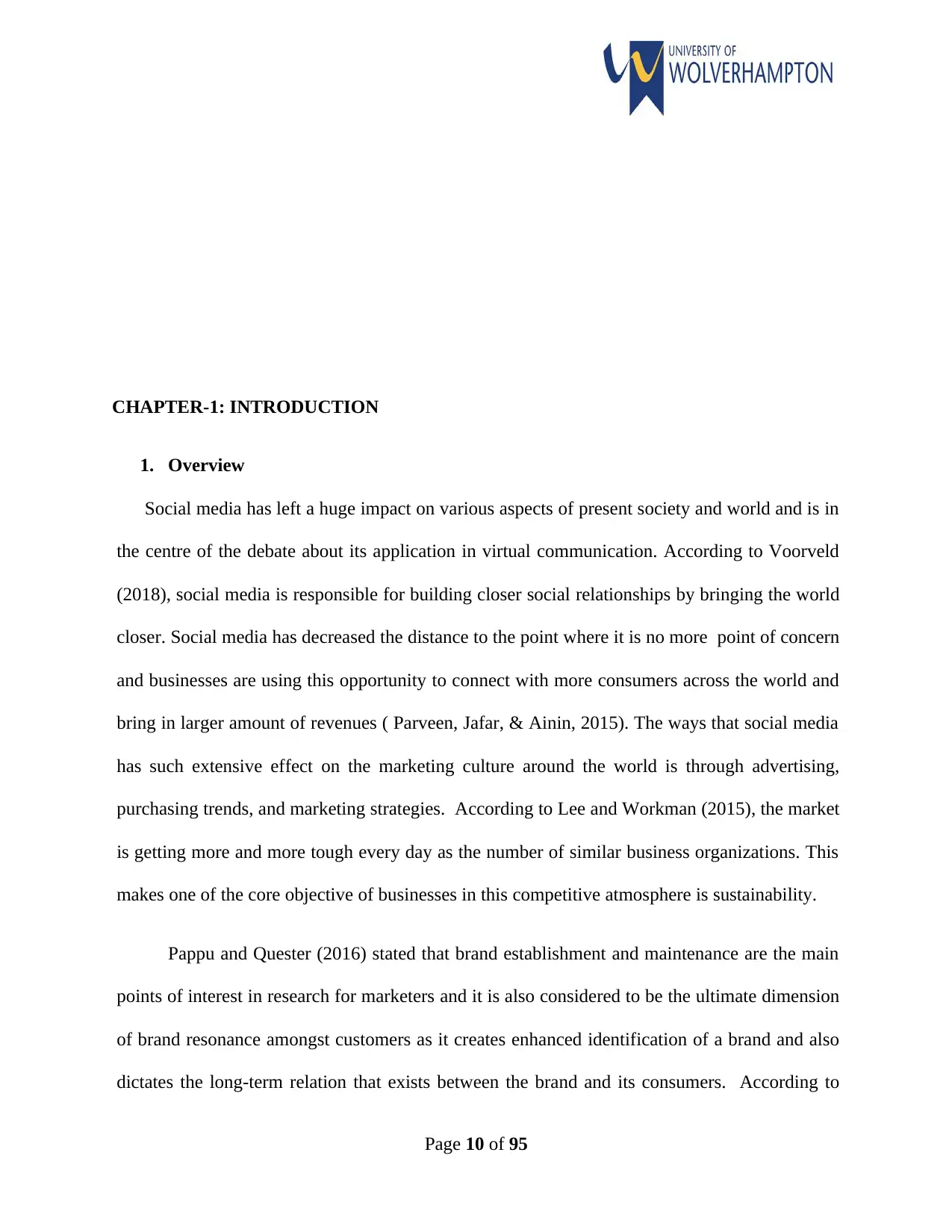
CHAPTER-1: INTRODUCTION
1. Overview
Social media has left a huge impact on various aspects of present society and world and is in
the centre of the debate about its application in virtual communication. According to Voorveld
(2018), social media is responsible for building closer social relationships by bringing the world
closer. Social media has decreased the distance to the point where it is no more point of concern
and businesses are using this opportunity to connect with more consumers across the world and
bring in larger amount of revenues ( Parveen, Jafar, & Ainin, 2015). The ways that social media
has such extensive effect on the marketing culture around the world is through advertising,
purchasing trends, and marketing strategies. According to Lee and Workman (2015), the market
is getting more and more tough every day as the number of similar business organizations. This
makes one of the core objective of businesses in this competitive atmosphere is sustainability.
Pappu and Quester (2016) stated that brand establishment and maintenance are the main
points of interest in research for marketers and it is also considered to be the ultimate dimension
of brand resonance amongst customers as it creates enhanced identification of a brand and also
dictates the long-term relation that exists between the brand and its consumers. According to
Page 10 of 95
1. Overview
Social media has left a huge impact on various aspects of present society and world and is in
the centre of the debate about its application in virtual communication. According to Voorveld
(2018), social media is responsible for building closer social relationships by bringing the world
closer. Social media has decreased the distance to the point where it is no more point of concern
and businesses are using this opportunity to connect with more consumers across the world and
bring in larger amount of revenues ( Parveen, Jafar, & Ainin, 2015). The ways that social media
has such extensive effect on the marketing culture around the world is through advertising,
purchasing trends, and marketing strategies. According to Lee and Workman (2015), the market
is getting more and more tough every day as the number of similar business organizations. This
makes one of the core objective of businesses in this competitive atmosphere is sustainability.
Pappu and Quester (2016) stated that brand establishment and maintenance are the main
points of interest in research for marketers and it is also considered to be the ultimate dimension
of brand resonance amongst customers as it creates enhanced identification of a brand and also
dictates the long-term relation that exists between the brand and its consumers. According to
Page 10 of 95
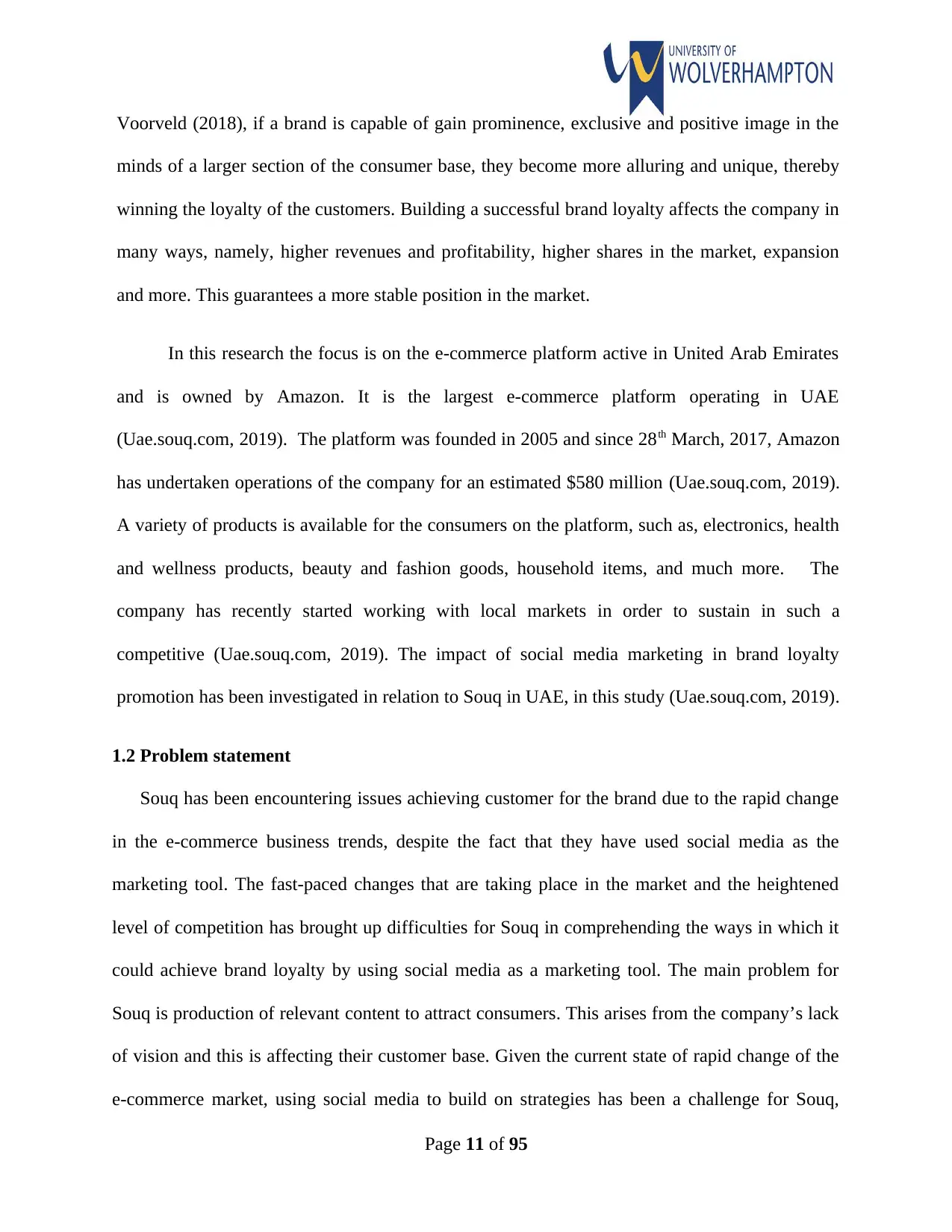
Voorveld (2018), if a brand is capable of gain prominence, exclusive and positive image in the
minds of a larger section of the consumer base, they become more alluring and unique, thereby
winning the loyalty of the customers. Building a successful brand loyalty affects the company in
many ways, namely, higher revenues and profitability, higher shares in the market, expansion
and more. This guarantees a more stable position in the market.
In this research the focus is on the e-commerce platform active in United Arab Emirates
and is owned by Amazon. It is the largest e-commerce platform operating in UAE
(Uae.souq.com, 2019). The platform was founded in 2005 and since 28th March, 2017, Amazon
has undertaken operations of the company for an estimated $580 million (Uae.souq.com, 2019).
A variety of products is available for the consumers on the platform, such as, electronics, health
and wellness products, beauty and fashion goods, household items, and much more. The
company has recently started working with local markets in order to sustain in such a
competitive (Uae.souq.com, 2019). The impact of social media marketing in brand loyalty
promotion has been investigated in relation to Souq in UAE, in this study (Uae.souq.com, 2019).
1.2 Problem statement
Souq has been encountering issues achieving customer for the brand due to the rapid change
in the e-commerce business trends, despite the fact that they have used social media as the
marketing tool. The fast-paced changes that are taking place in the market and the heightened
level of competition has brought up difficulties for Souq in comprehending the ways in which it
could achieve brand loyalty by using social media as a marketing tool. The main problem for
Souq is production of relevant content to attract consumers. This arises from the company’s lack
of vision and this is affecting their customer base. Given the current state of rapid change of the
e-commerce market, using social media to build on strategies has been a challenge for Souq,
Page 11 of 95
minds of a larger section of the consumer base, they become more alluring and unique, thereby
winning the loyalty of the customers. Building a successful brand loyalty affects the company in
many ways, namely, higher revenues and profitability, higher shares in the market, expansion
and more. This guarantees a more stable position in the market.
In this research the focus is on the e-commerce platform active in United Arab Emirates
and is owned by Amazon. It is the largest e-commerce platform operating in UAE
(Uae.souq.com, 2019). The platform was founded in 2005 and since 28th March, 2017, Amazon
has undertaken operations of the company for an estimated $580 million (Uae.souq.com, 2019).
A variety of products is available for the consumers on the platform, such as, electronics, health
and wellness products, beauty and fashion goods, household items, and much more. The
company has recently started working with local markets in order to sustain in such a
competitive (Uae.souq.com, 2019). The impact of social media marketing in brand loyalty
promotion has been investigated in relation to Souq in UAE, in this study (Uae.souq.com, 2019).
1.2 Problem statement
Souq has been encountering issues achieving customer for the brand due to the rapid change
in the e-commerce business trends, despite the fact that they have used social media as the
marketing tool. The fast-paced changes that are taking place in the market and the heightened
level of competition has brought up difficulties for Souq in comprehending the ways in which it
could achieve brand loyalty by using social media as a marketing tool. The main problem for
Souq is production of relevant content to attract consumers. This arises from the company’s lack
of vision and this is affecting their customer base. Given the current state of rapid change of the
e-commerce market, using social media to build on strategies has been a challenge for Souq,
Page 11 of 95
⊘ This is a preview!⊘
Do you want full access?
Subscribe today to unlock all pages.

Trusted by 1+ million students worldwide
1 out of 95
Related Documents
Your All-in-One AI-Powered Toolkit for Academic Success.
+13062052269
info@desklib.com
Available 24*7 on WhatsApp / Email
![[object Object]](/_next/static/media/star-bottom.7253800d.svg)
Unlock your academic potential
Copyright © 2020–2025 A2Z Services. All Rights Reserved. Developed and managed by ZUCOL.





